Gaziantep: The Soul of Turkish Food
I was very lucky to be invited to Gaziantep in south-east Turkiye in 2016 after UNESCO had recognised it as the 2015 Creative City of Gastronomy. The people I met there were so warm, generous and hospitable. My heart goes out to all those wonderful people after the devastating earthquake which hit the region, which includes northern Syria, a day ago.
The long table is set for breakfast. There are crinkly black olives, round brown olives, squares of fetta cheese, tomato wedges, cucumber crescents, creamy natural yoghurt, muscatels and almonds, soft white bread rolls, bowls of apricot nectar and honey, and a çaydanlık (or Turkish double teapot, similar to a samovar).
Lightly scrambled eggs are served separately in a sahan (a tinned copper frying dish with two decorative handles).
A typical Turkish breakfast, the sort of breakfast which would have been served in this courtyard a hundred years ago.
I couldn’t resist buying a couple of sahans at the copper market just down the street and have put fresh apricots and white and purple mulberries in them to add to our breakfast. The apricots (shekir pare) are the sweetest I’ve ever tasted, as are the fat white mulberries. Juices squirt everywhere as I bite into them.
It’s the setting which makes it exquisite, the sense of privacy and security from being surrounded by four metre high walls right in the centre of the bustling old city of Gaziantep, thick soft stone walls which keep you warm in winter and cool in summer.
And it’s the romantic architecture inside the courtyard which is so beguiling: the arched windows and doorways with exterior stone staircases lined with filigree ironwork, the bird houses, the leafy tree overhanging a fountain, the rooms with painted and beamed ceilings, the caves and secret passages.
Thanks to advice from Gaziantep’s dedicated culinary consultant Filiz Hosukoglu, I’m staying at Anadolu Evleri, a charming B&B in the old city. It’s across from Imam Cagdus, one of Gaziantep’s oldest and best known restaurants, famous for its pistachio baklavas and kebabs.
There are over twelve museums in Gaziantep and after breakfast I’ve planned to visit the Emine Göğüş Culinary Museum, a work of love by Filiz Hösükoğlu.
As I exit the courtyard through the old wooden door and turn the corner, I stumble into a group of men, their hair and eyelashes dusted with flour. They’re standing outside the back entrance to Imam Cagdus, taking a break from making baklava.
I walk down the stone stairs towards the mosque and make my way along a cobbled street to the museum which is set in an old wooden house on a corner.
Once inside, I’m taken on a tour of the stages of food preparation and cooking in a traditional Gaziantep household which includes displays of kitchen utensils, preservation and storage methods with fascinating tips on how to entertain guests and how to organise a family picnic.
There’s also an informative video where you can sit and sip tea. On the wall alongside the video are comments by well-known travellers to Gaziantep, one of which is by Stephen Kinzer, a New York Times editor:
“Some people believe the Garden of Eden was located near Urfa [a city 150Km east of Gaziantep] . If so, the people living there probably ordered their food from Gaziantep. The city is truly a world centre of cooking and eating. Its cuisine encompasses influences from a richly varied region as they have been filtered through the hands of generations of loving cooks. No-one can become a world class culinary traveller without coming to Gaziantep.”
In Turkiye, Gaziantep is widely regarded as the soul of Turkish cooking and was acknowledged as such by its recent UNESCO listing as a Creative City for Gastronomy. As Filiz points out:
“Many civilizations including Sumerian, Akkadian, Babylonian, Persian, Helenistic, Roman, Arabic, Mongolian and Ottoman have taken residence in the area called Mesopotamia, between the Dicle and Firat [Tigris and Euphrates] rivers. As one would expect, each civilization introduced its own and built on the culture of its predecessors, creating a “melting pot” of cultural and culinary tradition.”
Today, the melting pot continues. On my way back from the museum, I run into Hisham Asaleh, a Syrian who moved with his family to Gaziantep from Homs to escape the civil war. He is one of 400,000 Syrians now living in Gaziantep, many in camps set up by the Turkish government. A former plant engineer for Conoco Phillips, he and his younger brother now run a Syrian sweet shop called Aldalel Tatli and a casual eatery where they serve Syrian food (their falafels are outstanding).
“Turkiye can’t help everyone,” he tells me. “Nor can the UN, so we have to depend on ourselves. I left my country to be free. I’m living now for my [four] children. It’s a heavy life. I want to go home.”
While well provided for, most of the Syrians who live in the camps have no work and it’s part of Filiz’ job to find vocational training for them.
“They have everything,” she says. “Supermarkets, fridges, heaters, but no work, no sense of purpose.”
While it’s a truism that hospitality is one of the cornerstones of Turkish life, I was frequently humbled by the generosity of the local people.
That evening Filiz invited me, along with a handful of American food writers, including the late Barbara Hansen, to the home of her friend Kamuran Dover where we were shown how to prepare a number of traditional vegetarian Gaziantep dishes.
These included Bulgur Pilaf with tomato and capsicums (Domatesli bulgur pilav),an unusual and very tasty bread salad served in the shape of oblong balls called Omac, Roasted eggplant and tomato salad (Sebzeli söğürme) and a hearty Purslane stew (Pirpirim aşi). You’ll find the recipes well documented here by the Jerusalem Post food writer Faye Levy.
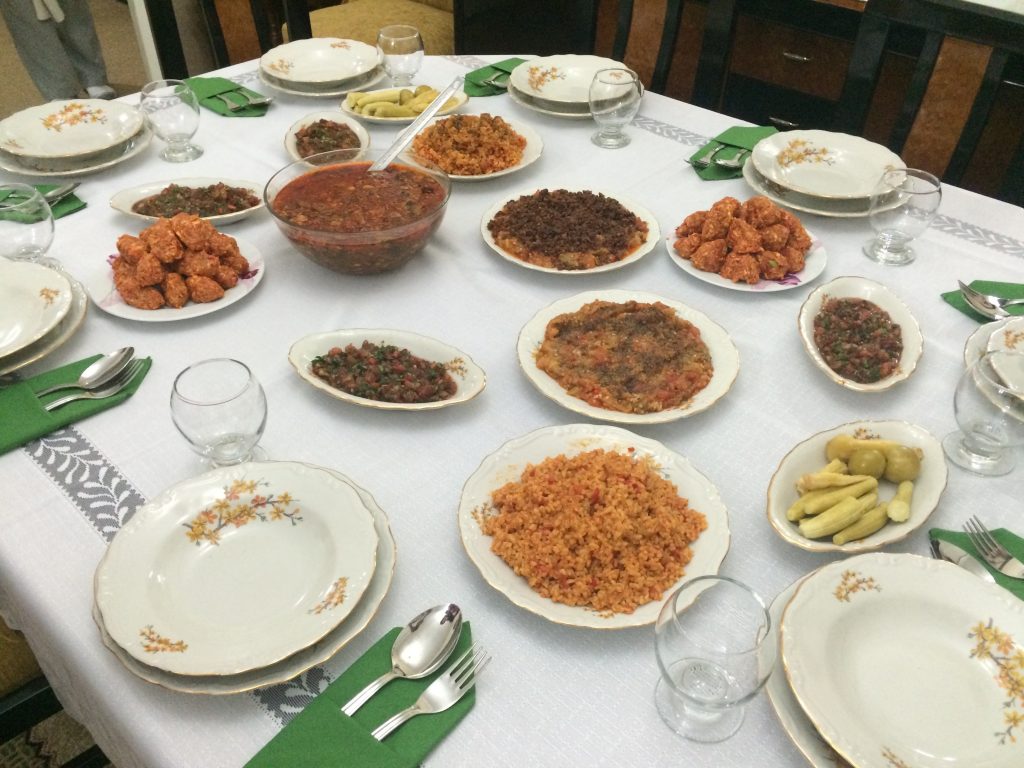
Kamuran Dover’s dinner table: Bulgur Pilaf in foreground; Eggplant and Tomato Salad on round plates behind (one of which is topped with minced lamb); Omac (in the shape of oblong balls) and the Puslane Stew in glass bowl with fresh tomato, capsicum, mint and parsley salad, dressed with sourcherry molasses in oval side dishes
This homely meal was a fitting end to the day and made me feel I’d stepped right into the heart and soul of traditional Gaziantep cuisine.

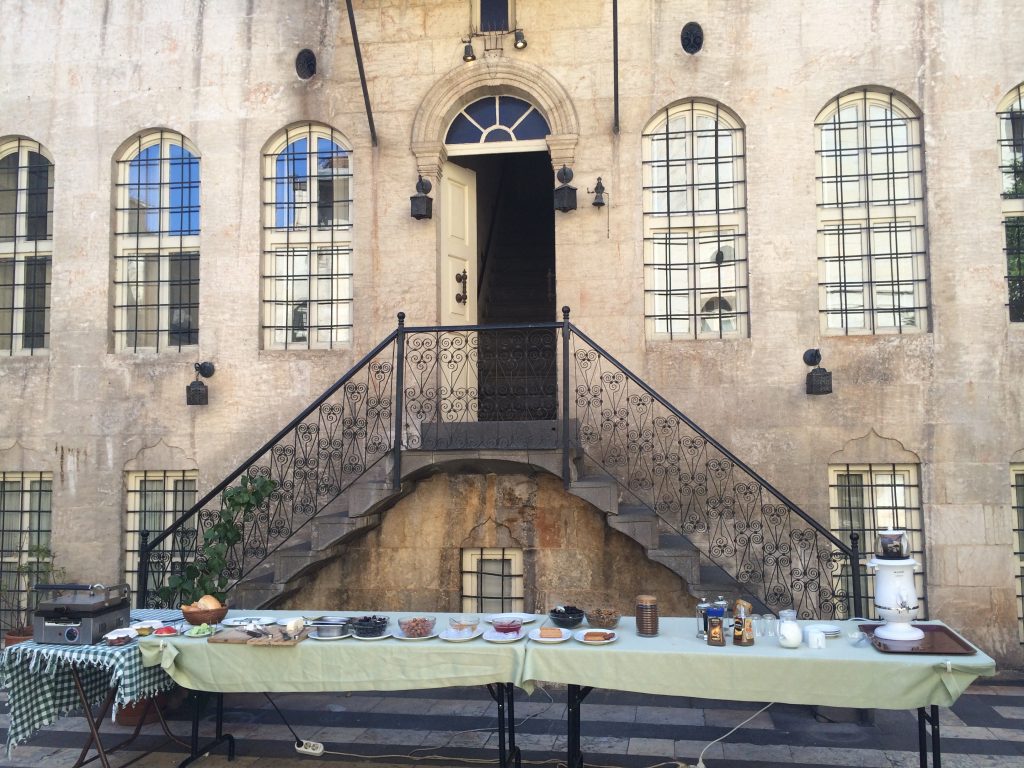
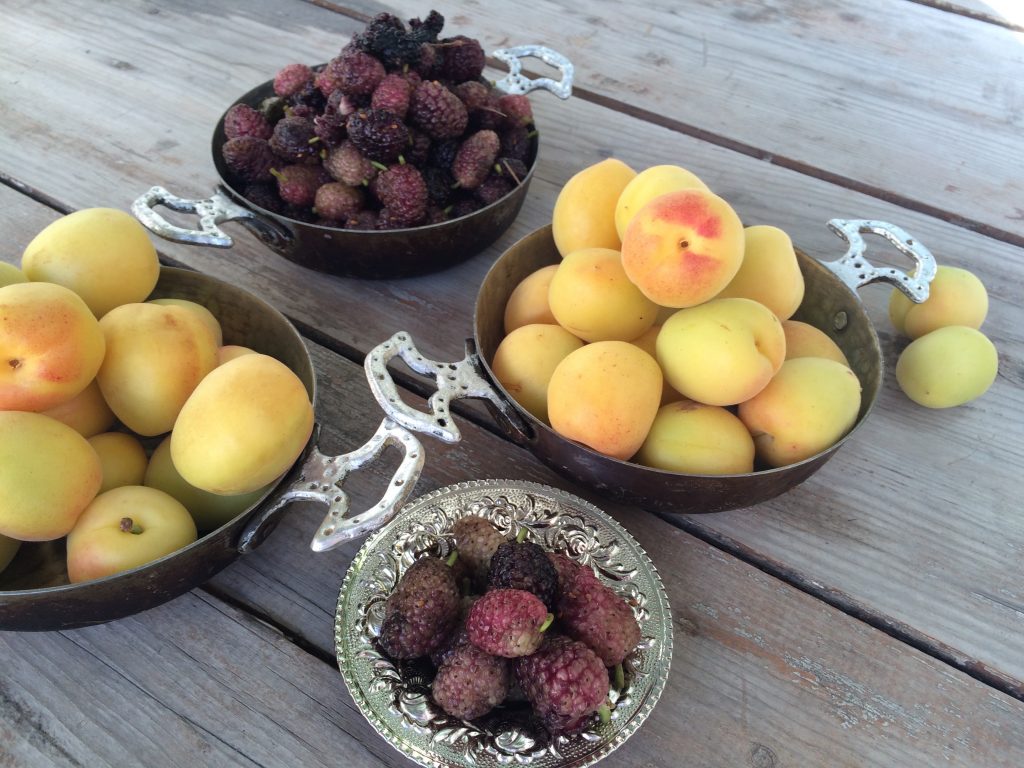
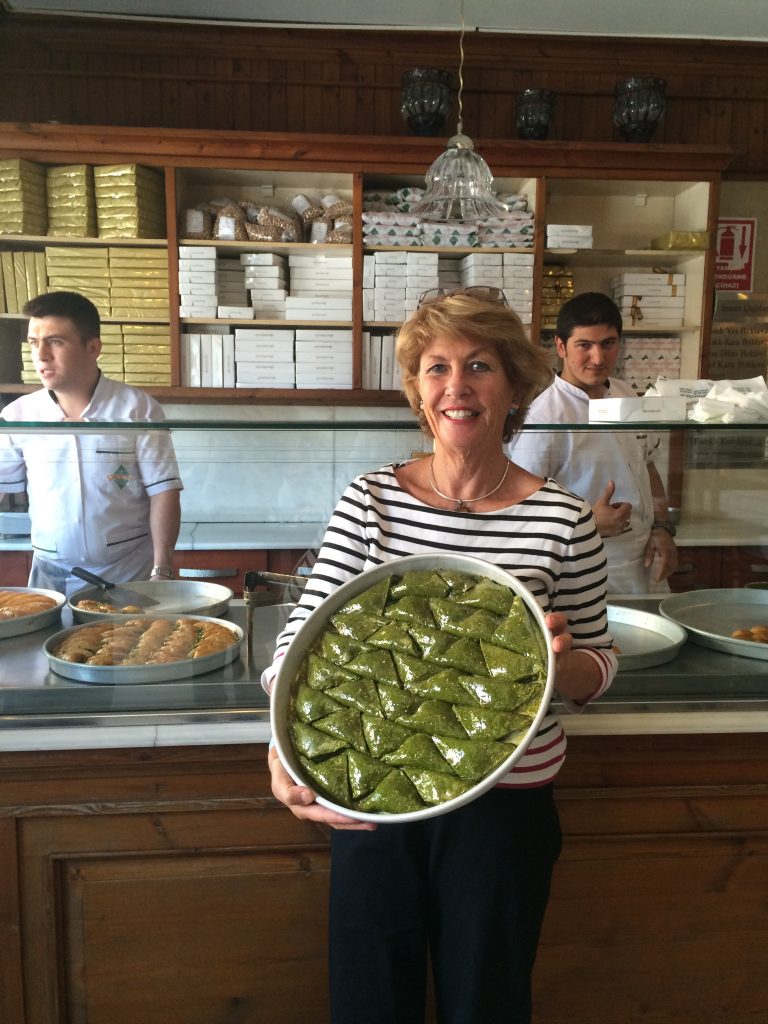
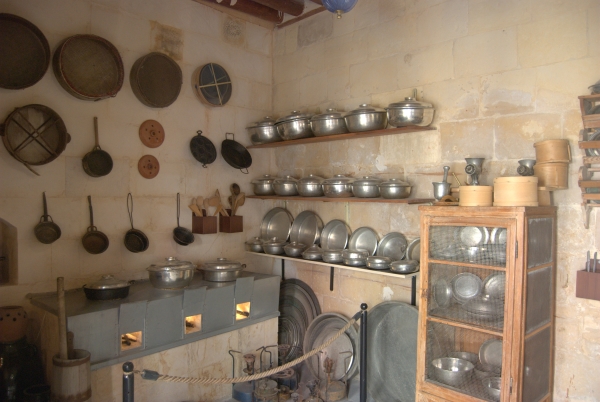
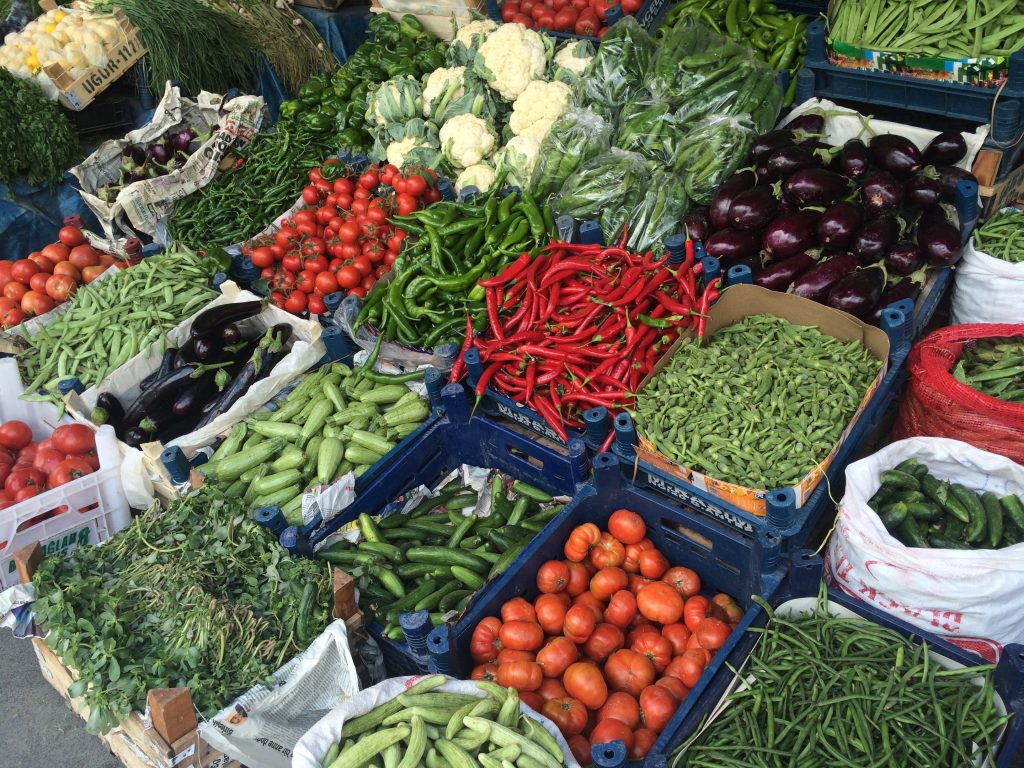
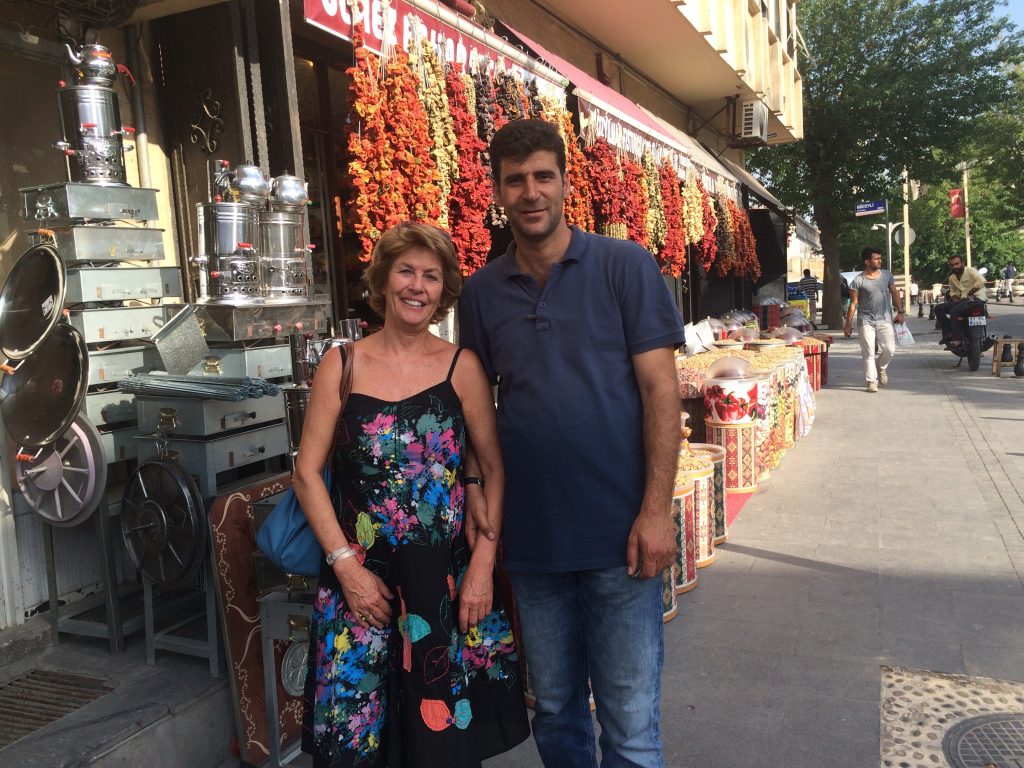
Sheridan, you have captured so well the multi-faceted experience of exploring Gaziantep, learning about its food and its people.
It was lovely to share a few meals with you. I hope we can do that again.
Thank you, Barbara…I also hope we can share a few meals together, maybe in L.A.